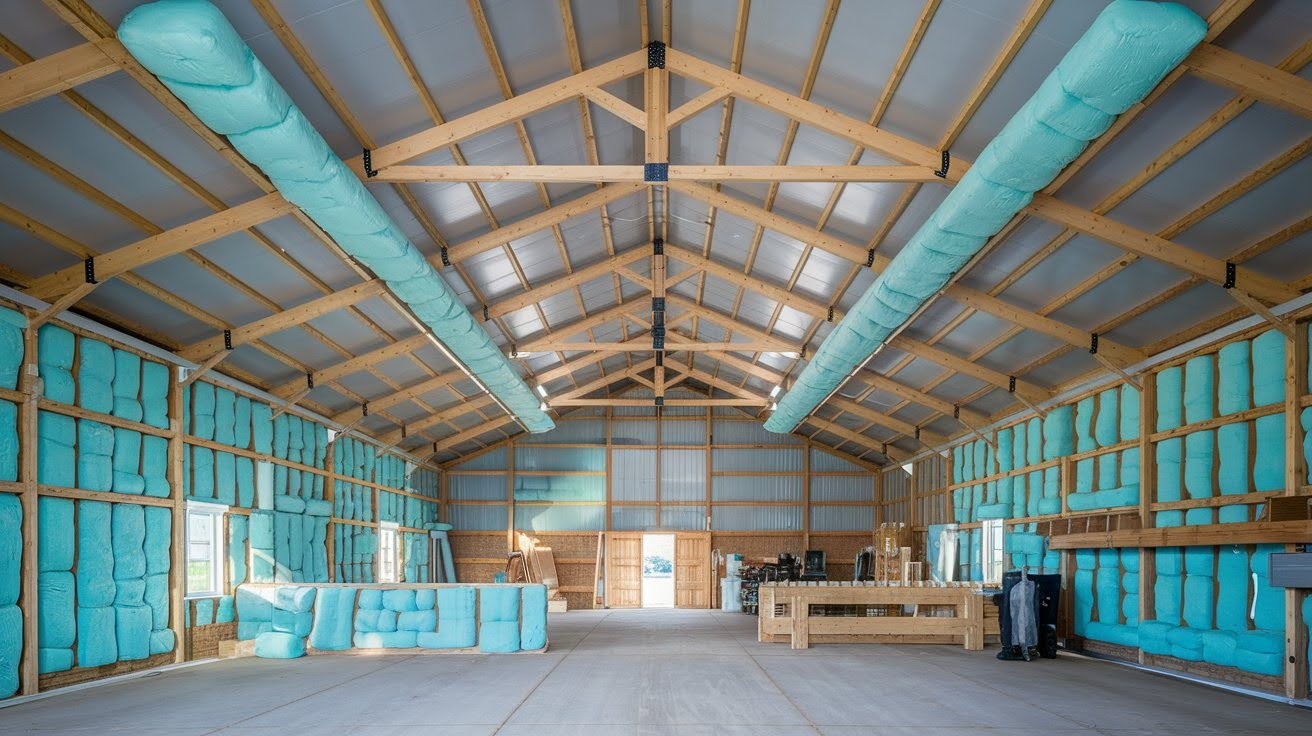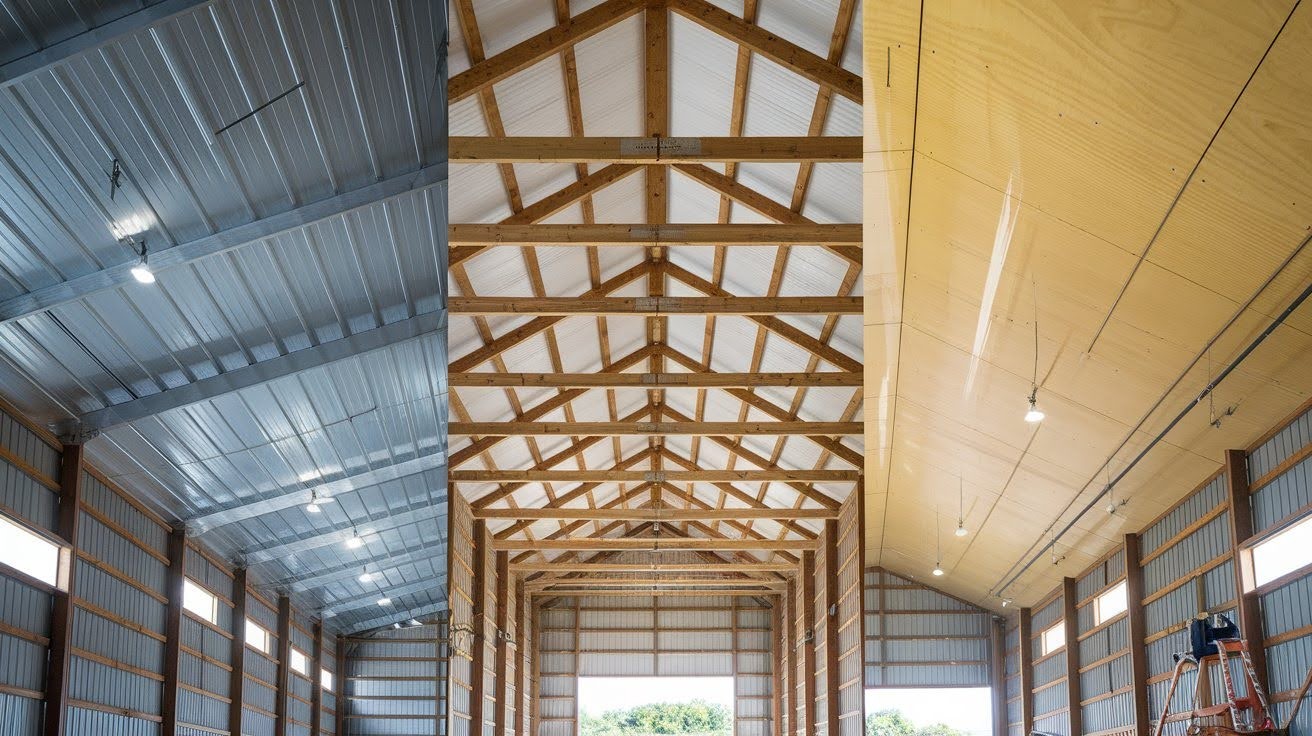Your pole barn has good bones and lots of potential but is more shed than hangout space. The good news states you can change that with this method.
Insulating and finishing the inside of your pole barn makes it feel warmer and more comfortable for living. It also gives it a complete feel. It also saves on energy and allows customization of floor plans.
Think about your plan for the space before proceeding too far. Will it be a workshop, storage shed, or living space of some kind?
Consider also your budget and the floor plan. This planning saves time and money for later.
Insulating Your Pole Barn Interior

Proper insulation controls temperature, reduces energy costs, and prevents moisture damage. Here’s what you need to know about insulation options.
Why Insulation Matters:
Good insulation keeps your pole barn comfortable year-round. It stops heat from escaping in winter and blocks it out during summer. You’ll notice stable temperatures that make the space more pleasant to work in.
Insulation also fights moisture problems. Without it, condensation builds up on cold surfaces. This leads to mold, rust, and wood rot. Proper insulation creates a barrier that protects your building and everything inside it.
Best Insulation Products:
- Spray Foam Insulation: gives you the best seal possible. It expands to fill every crack and gap. This means better energy efficiency and lower heating bills. The downside is the higher cost compared to other options.
- Batt Insulation: fits between your wall studs and ceiling joists. It’s budget-friendly and easy to install yourself. You can find it at any hardware store. Just wear protective gear when handling it.
- Rigid Foam Boards: work well in damp areas. They don’t absorb water like other materials. Install them on walls or under concrete floors. They provide solid insulation value and last for years.
Wall Finish Ideas for Pole Barn Interiors

Your wall choice sets the tone for your entire space. Pick materials that match your needs and style preferences.
Drywall for a Clean, Finished Look:
Drywall gives you smooth, paintable walls just like a regular house. It’s the top choice for barndominiums and living spaces. You can add any color or texture you want.
The installation takes more skill than other options. You’ll need to tape, mud, and sand the seams. But the result looks professional and polished.
Metal Wall Panels:
Metal panels stand up to heavy use without showing wear. They’re perfect for garages, workshops, and equipment storage. You can hose them down when they get dirty.
These panels install quickly and need almost no upkeep. They resist dents, moisture, and fire. Plus, they come in different colors and finishes.
Plywood or OSB Panels:
These wood panels offer strength and flexibility. You can mount heavy shelves, cabinets, or tools directly to them. No need to find studs first.
They cost less than most other options. Installation is straightforward with basic tools. Paint or stain them to match your preferred look.
Wood Plank or Shiplap Walls:
Real wood brings natural warmth to your space. Shiplap creates that modern farmhouse feel people love. Each board adds texture and character.
This option costs more than basic panels. But it makes your pole barn feel cozy and inviting. The wood also provides some natural insulation.
Ceiling Finish Options

The right ceiling finish affects lighting, temperature control, and the overall feel of your pole barn interior space.
1. Steel Ceiling Panels:
Steel panels bounce light around your space and make it feel brighter. You won’t need as many light fixtures to get good visibility. They also block moisture from getting through.
These panels are tough and fire-resistant. They won’t sag or warp over time. Cleaning is simple with just a damp cloth.
2. Exposed Wood Beams:
Leaving your beams visible gives you instant rustic style. You save money by skipping the ceiling finish altogether. The natural wood adds character that’s hard to replicate.
This works best when your structural beams look good. You might want to sand and seal them first. The open design also makes the space feel taller.
3. Plywood or Drop Ceilings:
Plywood sheets cover your ceiling quickly and cheaply. You can paint them any color you like. They’re solid and provide a finished look without breaking the bank.
Drop ceilings let you access wiring and pipes easily. The tiles are replaceable if one gets damaged. This option works well for spaces that need regular maintenance access.
Durable and Stylish Flooring Ideas

Your floor takes the most abuse in any pole barn. Choose materials that handle your activities and last for years.
1. Polished Concrete:
Polished concrete is practically indestructible. It handles heavy equipment, dropped tools, and constant foot traffic. Spills wipe up in seconds with no staining.
The smooth surface reflects light and looks clean. You won’t need to replace it for decades. It works for any type of pole barn use.
2. Epoxy Coated Floors:
Epoxy coating adds a glossy protective layer over concrete. It resists chemicals, oil, and water damage. The shiny finish makes your space look more professional.
You can choose from many colors and patterns. The coating fills small cracks and imperfections. It’s tougher than bare concrete and easier to sweep.
3. Vinyl Planks or Laminate:
These materials look like real hardwood but cost much less. They feel warmer and softer underfoot than concrete. Installation is simple with click-together pieces.
They work great for living spaces or home offices. The planks resist scratches and moisture reasonably well. Replace individual pieces if one gets damaged.
4. Rubber Mats or Interlocking Tiles:
Rubber flooring cushions your joints during workouts or long work sessions. The tiles snap together without glue or tools. You can remove and rearrange them anytime.
They grip well and prevent slips. Oil and chemicals won’t damage them. Perfect for gyms, workshops, or areas where you stand all day.
Maintenance and Upkeep Tips
Regular care keeps your pole barn interior looking good and working well. Small efforts now prevent big problems later on.
- Walk through your pole barn every few months and look for water leaks. Check metal parts for rust spots that need attention.
- Inspect your insulation for gaps or damage from animals. Catching problems early saves you money on repairs.
- Dust and dirt build up on all surfaces over time, so sweep floors and wipe down walls regularly. This prevents grime from becoming permanent.
- Metal panels may need occasional cleaning with mild soap and water. Wood surfaces benefit from fresh sealant every few years.
- A fresh coat of paint brightens up tired walls and refreshes your space. New lighting fixtures improve visibility and reduce eye strain.
- Add more electrical outlets or storage solutions as your needs change. Small upgrades keep your space functional and comfortable without major construction work.
Conclusion
At this point, you know how you may turn your pole barn into a usable space and using the right walls, ceilings, floors, and insulation, you should do this comfortably. Comfort and style may be important. Function is paramount above all.
Plan with care. Think through how you intend to use your space. Although higher quality materials cost more in the short term, they will last much longer than materials of lower quality that might need replacing in a few years.
If on a budget, build in stages, perhaps starting with insulation and some walls for shelter. And, you can add upgrades as we go. Get your pole barn built correctly, and it will last you decades.
Frequently Asked Questions
What is the best insulation for a pole barn interior?
Spray foam insulation offers the best performance by sealing all gaps and cracks completely. However, batt insulation works well for most people and costs much less while still providing good temperature control.
Can I finish a pole barn interior myself?
Yes, many finishing tasks like installing batt insulation, plywood panels, and basic flooring are DIY-friendly. More complex jobs like spray foam application or electrical work may require professional help for safety and quality results.
How much does it cost to finish a pole barn interior?
Costs vary widely based on size and materials, typically ranging from $5 to $30 per square foot. Basic finishes with plywood and concrete cost less, while drywall, epoxy floors, and spray foam increase the total investment.
Do I need a vapor barrier in my pole barn?
Yes, a vapor barrier prevents moisture from damaging your insulation and structure. Install it between the insulation and interior walls to block condensation and protect against mold growth.
What flooring works best for a workshop pole barn?
Polished concrete or epoxy-coated floors handle heavy tools and equipment best. They clean easily, resist stains and chemicals, and last for decades with minimal maintenance requirements.

